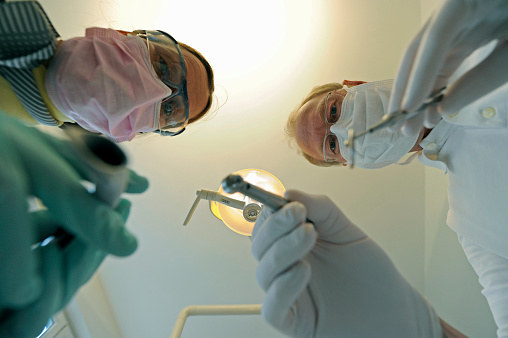 |
| Advertisement |
Researchers analyzed patients at a specialty treatment center in Virginia and found a 23-fold higher rate of a serious lung condition in dentists than would normally be expected.
Between 2000 and 2015, eight dentists and one dental technician developed a lung condition called idiopathic pulmonary fibrosis, and seven of the patients died.

The cluster of cases was seen in patients being treated at a specialty clinic in Virginia, according to a report released this week by the US Centers for Disease Control and Prevention (CDC).
Idiopathic pulmonary fibrosis is a chronic, progressive lung disease where the tissue of the lungs becomes thick and scarred over time, which makes it more difficult for the lungs to move oxygen into the bloodstream to supply the brain and other organs. The prognosis is poor, and the cause is unknown. The main symptoms are a slowly progressive shortness of breath, dry cough, weight loss, and fatigue.
The cases first came to light in April 2016, when a concerned Virginia dentist who had been recently diagnosed with idiopathic pulmonary fibrosis contacted the CDC to report that there were additional dentists in Virginia who also had the condition and had been treated at the same clinic.
The CDC reviewed 894 people treated for the lung condition at the clinic and found that eight worked as dentists and one as a dental technician — a 23-fold higher rate than would be expected based on the number of dentists in the US. The patients, all men, were aged 49 to 81 and practiced in Georgia, Maryland, and Virginia. They were treated between 2000 and 2015, and seven of them died.
Stockdevil / Getty Images / Via gettyimages.com
It's not clear why the cluster occurred, and it could be due to chance. But occupational exposures from dental work, such as inhaling airborne particles, could possibly contribute.

While no one knows what causes idiopathic pulmonary fibrosis, the risk is higher in men, people over 50, smokers, people with gastroesophageal reflux disease (acid reflux), and those who have a genetic risk for the condition or have had certain viral infections.
The condition has been linked to job-related and environmental hazards, including some medications and inhaling dust from bacteria and animal proteins, wood, metals, and silica.
But there is no known link to dentists or other dental personnel. However, dentists and other dental workers can be exposed to particles and chemical compounds when performing various tasks such as drilling, polishing, and preparing filling amalgams.
The substances used during these tasks include silica, polyvinyl siloxane, and other compounds that could be toxic to the lungs, according to the report. While it still isn't clear if or how these might play a role, it is possible that the occupational exposures are a factor.
Three of the patients were former smokers, one had never smoked, and the five remaining patients had an unknown smoking history, according to the report. It is unclear whether smoking in these patients contributed to the illness.
Phoenixns / Getty Images / Via gettyimages.com
Dental personnel have some required protections, mostly geared toward preventing infections.

The CDC recommends all dental health care professionals wear personal protective equipment (PPE), to prevent exposure to hazardous materials and infectious agents. These include gloves, eyewear, and masks or respirators. Certified respirators are fitted to the face and designed to filter out potentially hazardous particles in the air.
However, dental workers are not required to use respirators and often opt for surgical masks instead. While these masks do act as an effective barrier against some harmful agents, they do not effectively filter out small particles or provide nearly as much respiratory protection as a certified respirator.
In an interview, one of the two surviving patients noted that during 40 years of practice he did not use a National Institute for Occupational Safety and Health–certified respirator while polishing dental appliances, preparing amalgams and impressions, or developing X-rays using film-developing solutions, according to the report, although he did use a surgical mask during the last 20 years of practice.
Stewart Cohen / Getty Images / Via gettyimages.com
More research is needed to look at the potential health risks of dental work, according to the CDC.

There are currently no specific standards for dentistry from the Occupational Health and Safety Administration (OSHA), which is responsible for regulating workplace safety. However, OSHA's "General Industry" standards address some job exposures that may also apply to dentistry, which are used by the American Dental Association (ADA).
The ADA released the following statement to BuzzFeed News in an email: "The ADA takes very seriously the issue of occupational hazards. The ADA works in collaboration with OSHA and the CDC to ensure the best possible guidance is available for dental professionals."
Felix Vogel / Getty Images / Via gettyimages.com


0 comments: